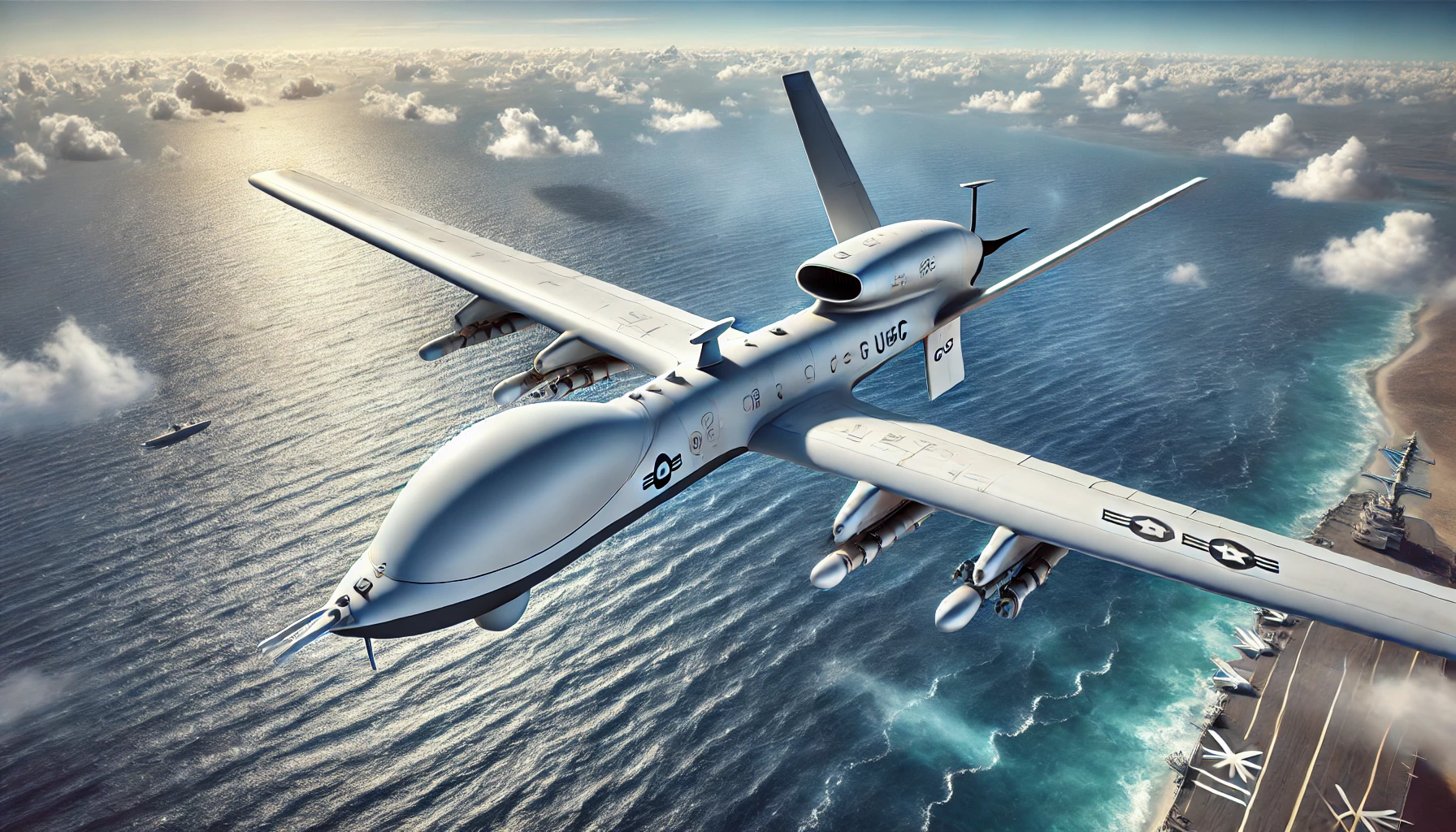
제목: 해군 고정익 무인기 기술과 적용 현황
현대 해군은 고정익 무인기(UAV)를 활용해 해상 작전에서 뛰어난 감시 및 정찰 능력을 발휘하고 있습니다. 이번 글에서는 해군 고정익 UAV의 기술적 특징과 구체적인 적용 현황에 대해 자세히 살펴보겠습니다.
1. 장거리 비행과 장시간 체공
고정익 UAV는 효율적인 연료 사용으로 장거리 비행이 가능해, 넓은 해역을 감시할 수 있습니다. 예를 들어, 미국 해군의 MQ-4C 트리톤은 최대 15,200km를 비행하며, 한 번 이륙하면 약 30시간 동안 체공할 수 있습니다. 이를 통해 해상에서 장시간 감시 임무를 수행하면서도 수시로 기지를 오가지 않아도 됩니다. 이 UAV의 순항 속도는 약 575km/h로, 필요 시 빠르게 이동해 목표 지역에 도달할 수 있습니다.
2. 고고도 비행과 넓은 감시 범위
고정익 UAV는 높은 고도에서 비행하며 넓은 범위를 관찰할 수 있는 장점이 있습니다. MQ-4C 트리톤은 최대 18,000m 고도에서 운용되어, 넓은 시야를 확보하고 광범위한 해역을 감시할 수 있습니다. 특히, 트리톤에 탑재된 고성능 레이더는 2,000해리(약 3,700km) 거리까지 목표물을 탐지할 수 있어, 장거리 해상 정찰 및 감시에 유리합니다.
3. 다양한 센서와 첨단 감시 장비
고정익 UAV는 다양한 센서를 장착해 해상에서 정보 수집 능력을 강화합니다. 예를 들어, MQ-4C 트리톤은 AN/ZPY-3 AESA 레이더를 사용하여 해상 및 공중 표적을 실시간으로 탐지합니다. 또한, 고해상도 EO/IR 카메라를 통해 해상 목표물을 실시간으로 식별하며, 전자전 장비를 활용해 적의 통신 신호를 수집하고 분석하는 SIGINT(통신 정보) 임무도 수행합니다.
4. 대잠수함 작전(ASW)과 소노부이 활용
해군 UAV는 대잠수함 작전(ASW)에도 유용하게 활용됩니다. 일부 고정익 UAV는 소노부이를 투하해 수중의 잠수함 신호를 감지합니다. 소노부이는 수중 음향 신호를 수집해, 잠수함 위치 파악에 중요한 역할을 합니다. UAV는 이 소노부이로부터 수집된 정보를 전송받아 잠수함의 위치와 활동을 감시합니다.
5. 해군 고정익 UAV의 대표 사례 – MQ-4C 트리톤
미 해군의 MQ-4C 트리톤은 고정익 UAV 중에서도 해상 감시에 특화된 모델입니다. 다음은 MQ-4C 트리톤의 주요 성능입니다.
• 최대 비행 거리: 약 15,200km
• 체공 시간: 약 30시간
• 최대 비행 고도: 18,000m
• 최대 감시 범위: 2,000해리 (3,700km)
• 탑재 센서: AN/ZPY-3 AESA 레이더, EO/IR 카메라, SIGINT 장비
이처럼 고정익 UAV는 해군의 중요한 자산으로 자리 잡고 있으며, 해상에서의 정보 수집, 정찰, 대잠수함 작전 등 다양한 임무에 투입되고 있습니다. 해군의 UAV는 기술의 발전과 함께 계속해서 강력한 해상 방어 체계를 구축하는 데 기여하고 있습니다.
Title: Naval Fixed-Wing UAV Technology and Applications
Modern navies are leveraging fixed-wing Unmanned Aerial Vehicles (UAVs) to provide enhanced surveillance and reconnaissance capabilities in maritime operations. In this article, we’ll explore the technical features and specific applications of naval fixed-wing UAVs.
1. Long-Range Flight and Extended Endurance
Fixed-wing UAVs can fly long distances with fuel efficiency, allowing them to cover vast areas of the ocean. For example, the MQ-4C Triton used by the U.S. Navy has a maximum flight range of up to 15,200 km and can stay airborne for approximately 30 hours per mission. This extended endurance enables it to conduct long-duration surveillance without frequent returns to base. With a cruising speed of around 575 km/h, it can also rapidly reach designated areas.
2. High-Altitude Flight and Wide Surveillance Coverage
Fixed-wing UAVs fly at high altitudes, enabling them to monitor extensive areas. The MQ-4C Triton, for instance, can operate at up to 18,000 meters in altitude, providing a broad field of view for wide-ranging surveillance. Its high-performance radar covers a maximum range of 2,000 nautical miles (approximately 3,700 km), making it well-suited for long-range maritime reconnaissance.
3. Advanced Sensors and Surveillance Equipment
Fixed-wing UAVs are equipped with diverse sensors to enhance intelligence-gathering capabilities at sea. The MQ-4C Triton, for example, utilizes an AN/ZPY-3 AESA radar that detects maritime and airborne targets in real time. In addition, its high-resolution EO/IR cameras can visually identify maritime objects, while its electronic warfare systems enable SIGINT (Signals Intelligence) operations, capturing and analyzing enemy communication signals.
4. Anti-Submarine Warfare (ASW) with Sonobuoy Deployment
Naval UAVs are valuable in anti-submarine warfare (ASW) as well. Some fixed-wing UAVs can deploy sonobuoys to detect underwater submarine signals. These sonobuoys gather acoustic data from the water, aiding in locating submarines. The UAV can then receive the data from these sonobuoys, providing real-time monitoring of submarine positions and activities.
5. Key Example – The MQ-4C Triton
The U.S. Navy’s MQ-4C Triton is a prime example of a fixed-wing UAV specialized in maritime surveillance. Here are some of its core specifications:
• Maximum Flight Range: Approximately 15,200 km
• Endurance: About 30 hours
• Maximum Altitude: 18,000 meters
• Surveillance Range: 2,000 nautical miles (3,700 km)
• Key Sensors: AN/ZPY-3 AESA radar, EO/IR camera, SIGINT equipment
In conclusion, fixed-wing UAVs are becoming essential assets for navies, serving a range of missions such as intelligence collection, reconnaissance, and anti-submarine operations. As technology advances, these UAVs will continue to strengthen naval defense capabilities at sea.
'최신 기술' 카테고리의 다른 글
| 세계의 인기 놀이기구와 최신 기술 소개 (Popular Rides and Advanced Technology) (3) | 2024.11.14 |
|---|---|
| 기계공학으로 보는 AAM 핵심 기술: AAM Core Technologies Through Mechanical Engineering (0) | 2024.11.13 |
| 해양 탐사 로봇: Marine Exploration Robot Technology (0) | 2024.11.12 |
| 비트코인과 기계공학: The Technical Connection Between M.E. and the Coin Industry (0) | 2024.11.08 |
| HBM: 고성능 메모리의 미래와 DRAM 비교 (0) | 2024.11.08 |




댓글